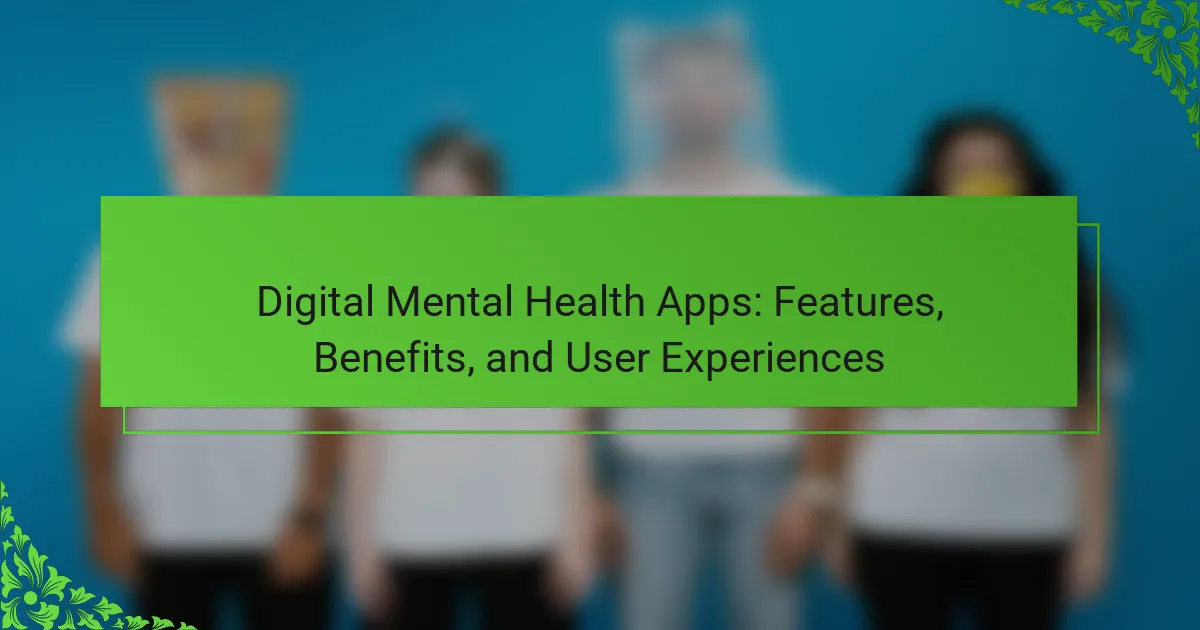Digital mental health apps offer increased accessibility and personalized support for improving mental well-being. Key features include mood tracking, guided exercises, and community support. Users experience challenges like engagement and privacy concerns, while unique attributes like AI-driven insights enhance their effectiveness. This article explores the features, benefits, and user experiences associated with these innovative tools.
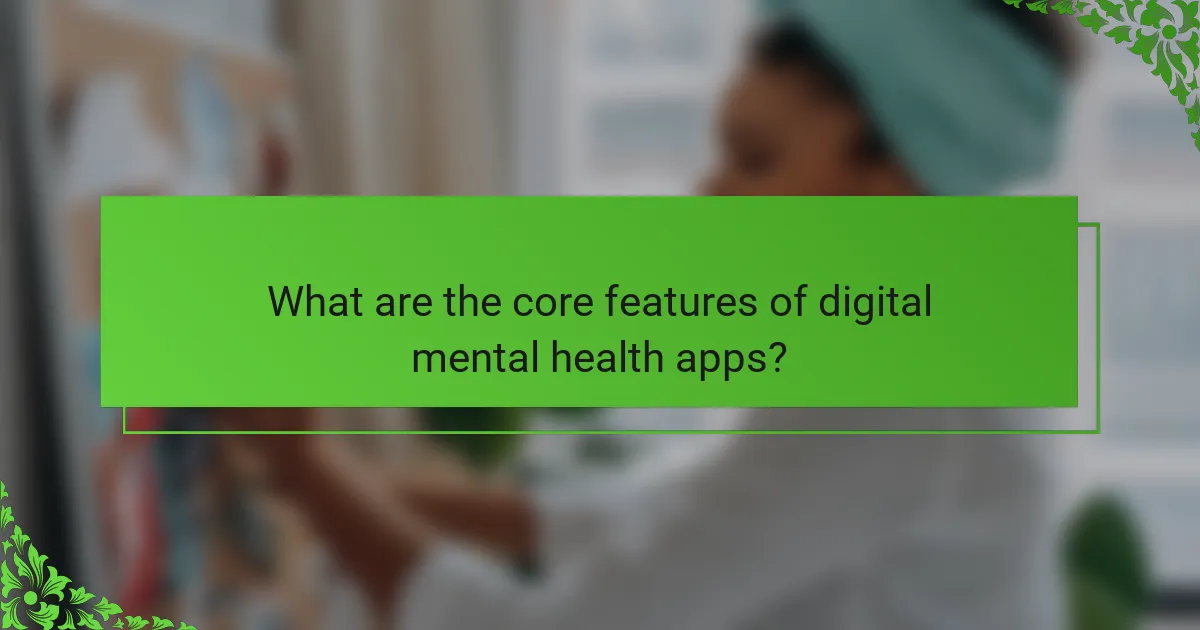
What are the core features of digital mental health apps?
Digital mental health apps typically feature user-friendly interfaces, personalized content, and secure data handling. They often include mental health assessments, mood tracking, and guided exercises. These features enhance accessibility and user engagement, promoting mental well-being. Additionally, many apps incorporate community support and professional resources, fostering a holistic approach to mental health care.
How do user-friendly interfaces enhance engagement?
User-friendly interfaces significantly enhance engagement in digital mental health apps by promoting ease of use and accessibility. These interfaces reduce barriers to entry, encouraging users to interact more frequently. Features like intuitive navigation, personalized content, and visually appealing designs foster a welcoming environment. As a result, users are more likely to explore app functionalities, leading to improved mental health outcomes. A study indicated that apps with user-friendly designs can increase user retention rates by up to 50%.
Which tracking and monitoring tools are commonly used?
Commonly used tracking and monitoring tools in digital mental health apps include mood trackers, journaling features, and symptom checkers. These tools help users assess their mental well-being and identify patterns over time. Popular examples are Headspace, Calm, and Moodfit, which offer personalized insights based on user input. As a result, users can better manage their mental health through data-driven approaches.
What types of therapeutic approaches do these apps support?
Digital mental health apps support various therapeutic approaches, including cognitive behavioral therapy, mindfulness practices, and emotional regulation techniques. These apps often integrate features like guided meditations, mood tracking, and personalized feedback to enhance user engagement. Many also offer community support and professional resources, making mental health care more accessible. Users benefit from the flexibility of accessing these therapeutic tools anytime, promoting consistent self-care practices.
How do privacy and security measures affect user trust?
Privacy and security measures significantly enhance user trust in digital mental health apps. When users feel their personal data is protected, they are more likely to engage with the app consistently. High-level encryption, transparent data usage policies, and user control over personal information are critical features that build this trust. A study found that 70% of users prioritize data security when choosing mental health apps. As a result, incorporating robust privacy features can lead to increased user retention and satisfaction.

What benefits do users experience from digital mental health apps?
Users experience various benefits from digital mental health apps, including increased accessibility, personalized support, and improved mental well-being. These apps provide immediate resources, such as guided meditations and cognitive behavioral therapy techniques, which can enhance emotional resilience.
Additionally, users report greater convenience in managing their mental health, as they can access tools anytime and anywhere. Data indicates that 70% of users feel more empowered to handle stress after using these applications.
The unique attribute of these apps is their ability to track user progress over time, offering insights into mood patterns and triggers. This feature fosters a proactive approach to mental health management, promoting sustained engagement and improvement.
How do these apps improve accessibility to mental health resources?
Digital mental health apps enhance accessibility to resources through convenience, anonymity, and diverse offerings. Users can access support anytime, reducing barriers associated with traditional therapy. These apps often feature self-assessment tools, guided exercises, and community forums, making mental health care more approachable. As a result, individuals who may hesitate to seek help can engage with resources comfortably and privately.
What role do digital mental health apps play in reducing stigma?
Digital mental health apps play a crucial role in reducing stigma by providing accessible support and fostering open conversations. These platforms allow users to engage with mental health resources anonymously, which encourages individuals to seek help without fear of judgment. Features like community forums and educational content promote understanding and empathy, contributing to a shift in societal attitudes. As a result, these apps empower users to share experiences and normalize discussions around mental health, ultimately diminishing stigma associated with seeking help.
How can users track progress and outcomes effectively?
Users can track progress and outcomes effectively by utilizing built-in analytics and goal-setting features in digital mental health apps. These apps often provide visual progress charts and feedback mechanisms that help users monitor their mental health journey. Regular check-ins and reminders encourage consistent engagement, enhancing user experiences. Additionally, personalized insights based on user data can highlight trends and areas for improvement, fostering a deeper understanding of mental health progress.
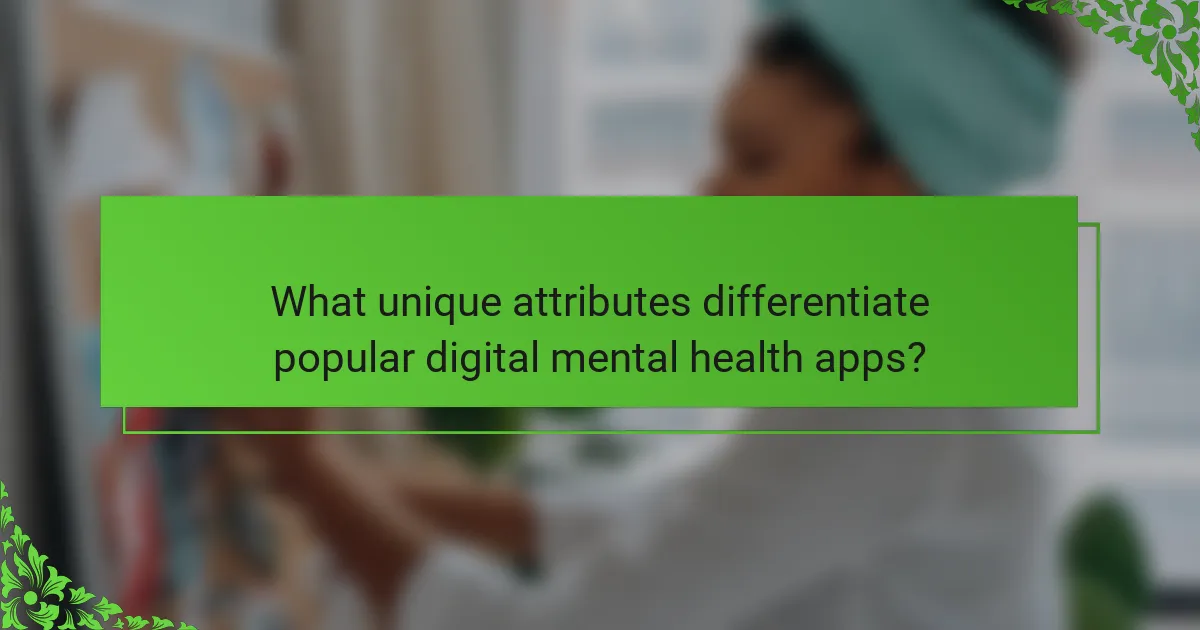
What unique attributes differentiate popular digital mental health apps?
Popular digital mental health apps are differentiated by unique attributes such as personalized therapy options, integration with wearable devices, and real-time mood tracking. These features enhance user engagement and adaptability to individual needs. Additionally, some apps offer unique community support features, connecting users for shared experiences. Others may provide rare attributes like AI-driven insights, which analyze user behavior for tailored recommendations.
How do gamification elements influence user motivation?
Gamification elements significantly enhance user motivation in digital mental health apps. These features, such as rewards and progress tracking, create a sense of achievement. Users feel more engaged and committed to their mental health journeys when they experience measurable progress and receive positive reinforcement.
Incorporating game-like elements can lead to increased user retention. For example, a study found that apps with gamification features saw a 30% higher retention rate compared to those without. This unique attribute of gamified apps fosters a supportive environment for users to explore mental health resources.
Additionally, social competition can motivate users to participate more actively. Leaderboards and challenges encourage users to engage consistently, driving a communal aspect of mental health improvement. As a result, users often report feeling more connected and motivated to achieve their goals.
Which unique community features foster peer support?
Digital mental health apps foster peer support through unique community features such as forums, chat groups, and peer mentoring. These elements encourage users to share experiences and provide emotional support.
Forums allow users to discuss challenges and coping strategies in a safe environment. Chat groups facilitate real-time conversations, enhancing connection among users. Peer mentoring connects individuals with trained peers for guidance, promoting accountability and motivation.
These features create a sense of belonging and reduce feelings of isolation, significantly enhancing user engagement and satisfaction.
What innovative technologies are being integrated into these apps?
Digital mental health apps are integrating innovative technologies like artificial intelligence, virtual reality, and wearables. These technologies enhance user engagement, personalize experiences, and provide real-time data analysis. AI algorithms can tailor interventions based on user behavior, while virtual reality offers immersive therapy environments. Wearable devices track physiological metrics, enabling apps to provide timely mental health insights. This integration improves accessibility and effectiveness in mental health support.
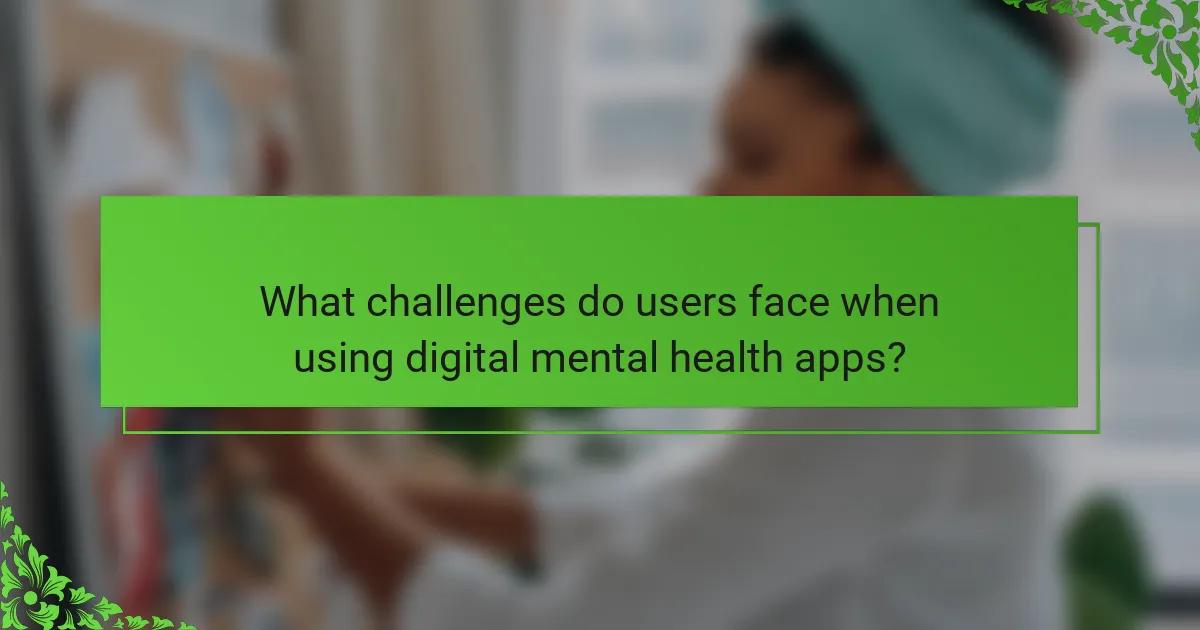
What challenges do users face when using digital mental health apps?
Users face several challenges when using digital mental health apps, including issues with engagement, privacy concerns, and effectiveness. Many users struggle to maintain consistent usage, leading to incomplete progress. Privacy concerns arise from data sharing and security, which can deter users from fully engaging. Additionally, the effectiveness of these apps varies widely, with some lacking evidence-based practices, making it difficult for users to achieve their mental health goals.
How do users navigate issues of consistency and engagement?
Users navigate issues of consistency and engagement in digital mental health apps through personalized features and community support. These apps often provide tailored content based on user preferences, enhancing engagement. Regular reminders and progress tracking foster consistency in usage. Additionally, community forums and peer support options create a sense of belonging, encouraging users to stay engaged. Research shows that apps with interactive features report higher user retention rates.
What common technical problems do users encounter?
Users commonly encounter technical problems with digital mental health apps, including connectivity issues, app crashes, and user interface difficulties. Connectivity issues can prevent users from accessing resources or engaging in sessions. App crashes disrupt the user experience, leading to frustration. User interface difficulties may include navigation challenges, making it hard for users to find features. These problems can hinder the effectiveness of the apps, impacting user satisfaction and engagement.
How do cultural factors impact user experiences and expectations?
Cultural factors significantly influence user experiences and expectations in digital mental health apps. Users from different backgrounds may prioritize varying features based on cultural beliefs, stigma, and accessibility. For example, some cultures may value anonymity and privacy more, impacting the design and functionality of these apps. Additionally, language and cultural context affect how mental health concepts are understood and addressed within the app, leading to diverse user engagement and satisfaction levels. Understanding these factors is crucial for developers aiming to create inclusive and effective mental health solutions.
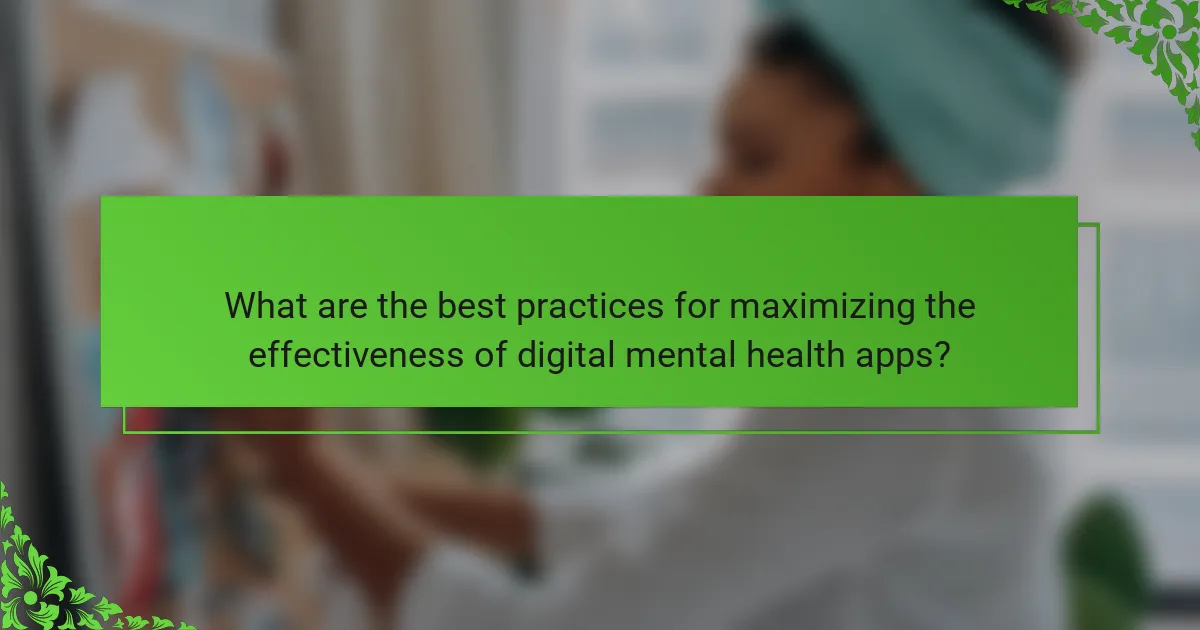
What are the best practices for maximizing the effectiveness of digital mental health apps?
To maximize the effectiveness of digital mental health apps, prioritize user engagement, personalization, and evidence-based content. Regular updates and user feedback integration enhance the experience.
1. Ensure user-friendly design for easy navigation.
2. Incorporate personalized features that adapt to user needs.
3. Provide evidence-based resources and interventions.
4. Facilitate community support through forums or chat functions.
5. Regularly update content to maintain relevance.
6. Gather and implement user feedback for continuous improvement.
How can users set realistic goals for their mental health journey?
Users can set realistic goals for their mental health journey by utilizing digital mental health apps effectively. Begin by defining specific, measurable, achievable, relevant, and time-bound (SMART) goals. Digital apps often provide features like mood tracking, goal setting, and progress monitoring, which help users stay accountable.
Regularly review and adjust goals based on personal experiences and feedback from the app. Engaging with community features within the app can also provide support and motivation. Lastly, remember that mental health improvement is a gradual process, and celebrating small victories can enhance motivation and resilience.
What strategies help maintain user motivation over time?
Digital mental health apps can maintain user motivation through personalized features, regular reminders, and community support. Personalized content keeps users engaged by addressing their unique needs. Regular reminders encourage consistent usage, while community support fosters accountability and shared experiences. These strategies enhance user retention and satisfaction.
How can users ensure they are choosing the right app for their needs?
To choose the right digital mental health app, users should evaluate features, benefits, and user experiences. Consider the following factors:
1. **Specific Needs**: Identify personal mental health goals, such as anxiety management or mood tracking.
2. **Features**: Look for essential features like guided meditations, mood tracking, or therapy chat options.
3. **User Reviews**: Read user experiences to gauge effectiveness and usability.
4. **Professional Endorsement**: Check if the app is backed by mental health professionals for credibility.
5. **Privacy and Security**: Ensure the app complies with data protection regulations to safeguard personal information.
